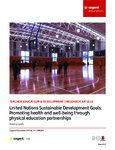United Nations Sustainable Development Goals: Promoting health and well-being through physical education partnerships
| dc.contributor.author | Lynch, TJ | en |
| dc.date.accessioned | 2016-06-09T07:51:33Z | |
| dc.date.available | 2016-06-09T07:51:33Z | |
| dc.date.issued | 2016-06-07 | en |
| dc.identifier.uri | http://hdl.handle.net/10026.1/4868 | |
| dc.description | The United Nations recently approved the Sustainable Development Goals (SDGs) which forms a guideline policy for all nations. While the UN have strongly advised that partnerships are essential for the implementation of these global goals, within local communities there is little evidence of how this is best done or what it looks like in practice. This paper shares a health and wellbeing community initiative that achieves goals three and four of the SDGs, and in doing so models how to implement physical education partnerships as advocated by the UN. The highly successful innovative initiative is “Best Start: A community collaborative approach to lifelong health and wellness” (2011–2014). | en |
| dc.description.abstract |
This paper shares a health and wellbeing partnership, modelling implementation of physical education (PE) advocated by the United Nations (UN). The Sustainable Development Goals (SDGs) exemplifies global efforts towards equality, specifically Goal 3 and 4 address health and wellbeing. The purpose of this paper is to provide insights into cross sector “partnerships”, identified as essential for the implementation of the SDGs. This is significant as the UN acknowledge a present gap of information on partnerships in action and a need for reporting from the ground level. The project “Best Start: A community collaborative approach to lifelong health and wellness”, began as a partnership between a university and nearby schools and quickly grew to involve Australian Registered Training Organisations, the local health industry, Education departments and sport governing bodies. The collaborations involved pre-service teachers teaching Health and PE lessons to children in a disadvantaged socio-economic area, creating valuable learning experiences for stakeholders. Local and global communities were involved in research and reform. The project creatively optimised resources available through state, Australian and international connections. International partnerships enabled identification of unique contextual opportunities. Programme planning was strengthened with data gathered from an England and Wales Ofsted awarded Primary Physical Education course. Various methods, including; semi-structured interviews, reflective journal, observations, document analysis, and Student Evaluation of Teaching Units (SETU) were adopted. SETU is valid and reliable data collected by the university for the purposes of research. The findings support that partnerships enable SDG implementation and the research paper offers direction for localisation. | en |
| dc.format.extent | 1 - 15 (15) | en |
| dc.language.iso | en | en |
| dc.publisher | Taylor & Francis | en |
| dc.subject | Sustainable Development Goals | en |
| dc.subject | Partnerships | en |
| dc.subject | Physical Education | en |
| dc.subject | well-being | en |
| dc.subject | health | en |
| dc.subject | teacher education | en |
| dc.subject | strength-based approach | en |
| dc.title | United Nations Sustainable Development Goals: Promoting health and well-being through physical education partnerships | en |
| dc.type | Journal Article | |
| plymouth.author-url | http://www.timothylyncheducation.com/ | en |
| plymouth.issue | 1188469 | en |
| plymouth.volume | 3 | en |
| plymouth.publisher-url | http://www.tandfonline.com/ | en |
| plymouth.journal | Cogent education | en |
| dc.identifier.doi | 10.1080/2331186X.2016.1188469 | en |
| plymouth.organisational-group | /Plymouth | |
| dcterms.dateAccepted | 2016-05-06 | en |
| dc.rights.embargoperiod | Not known | en |
| rioxxterms.versionofrecord | 10.1080/2331186X.2016.1188469 | en |
| rioxxterms.licenseref.uri | http://www.rioxx.net/licenses/all-rights-reserved | en |
| rioxxterms.licenseref.startdate | 2016-06-07 | en |
| rioxxterms.type | Journal Article/Review | en |
| plymouth.oa-location | http://cogentoa.tandfonline.com/doi/full/10.1080/2331186X.2016.1188469 | en |


